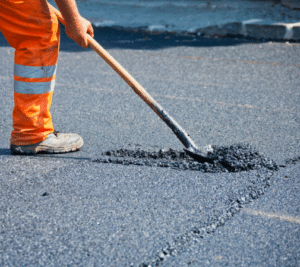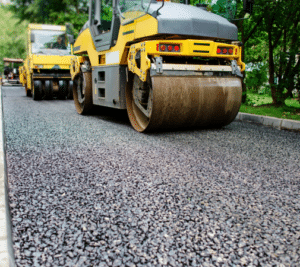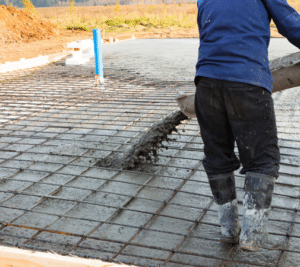Introduction
Maintaining commercial paving is essential for ensuring longevity, safety, and visual appeal of properties. Whether it is parking lots, driveways, or walkways, regular upkeep plays a vital role in preserving the integrity of these surfaces.
Proactive maintenance is key to reducing long-term repair costs and extending the life of paving investments. Rather than waiting for noticeable damages or hazards to arise, addressing issues in their early stages can prevent them from escalating into more significant problems. By implementing a comprehensive maintenance plan, property owners and managers can prioritize timely repairs and preventive measures.
Investing in regular cleaning, sealing, and patching can go a long way in protecting the surface from the damaging effects of weather, heavy traffic, and other external factors. By doing so, property owners can maintain a safe and functional environment for customers, visitors, and employees. Additionally, prioritizing the visual appeal of the paving enhances the overall aesthetic of the property, leaving a positive impression on guests and potential clients.
Maintaining commercial paving is crucial for its longevity, safety, and visual appeal. Through proactive maintenance, property owners and managers can save costs by addressing issues early on and extending the lifespan of their paving investments.

Routine Inspection and Assessment
Regular inspections play a critical role in the effective maintenance of commercial property paving investments. By conducting routine inspections, property owners and managers can identify potential issues before they escalate into major problems, saving time and money in the long run.
To ensure the longevity of the paving, it is essential to conduct inspections at regular intervals. The frequency of these inspections may vary depending on various factors, such as the amount of foot or vehicular traffic, environmental conditions, and the quality of the paving material. However, a general guideline is to inspect the pavement at least twice a year, preferably in the spring and fall seasons.
During these inspections, it is important to pay close attention to signs of wear and damage. These signs may include cracks, potholes, uneven surfaces, faded markings, and drainage issues. Identifying these signs early on allows property owners and managers to take timely action and prevent further deterioration of the pavement.
In addition to visual inspections, it may be beneficial to utilize advanced technology, such as infrared scanning or ground-penetrating radar, to detect underlying issues that may not be visible to the naked eye.
By regularly inspecting and assessing the condition of the pavement, commercial property owners and managers can proactively address any maintenance or repair needs. This not only ensures the safety and performance of the paving but also helps to maintain its aesthetic appeal for years to come.
Cleaning and Debris Removal
Regular cleaning and removal of debris is crucial for maintaining the aesthetic appeal and overall condition of commercial property paving. Debris such as leaves, dirt, trash, and other materials can not only be unsightly but can also cause significant damage to the pavement if left unattended.
By regularly sweeping and removing debris from the paved surfaces, property owners and managers can prevent potential hazards and extend the lifespan of the pavement. Debris left on the pavement can trap moisture, leading to the growth of mold, mildew, and algae, which can deteriorate the pavement over time. Additionally, leaves and other organic matter can stain and discolor the surface, diminishing its appearance.
Best practices for cleaning different types of paving materials can vary. For concrete pavements, regular sweeping and washing with mild detergents can effectively remove dirt and stains. Avoiding harsh chemicals or high-pressure washing is crucial to prevent damage to the surface.
For asphalt pavement, regular sweeping should be complemented with periodic seal coating to protect against cracks and deterioration. Oil spills and other stains should be addressed promptly to prevent staining and potential degradation of the asphalt.
Overall, regular cleaning and debris removal should be a priority for commercial property owners and managers. By implementing appropriate cleaning practices, they can preserve the aesthetic appeal, safety, and performance of their paving investments for years to come.
Crack Filling and Sealcoating
Crack filling and sealcoating are essential maintenance practices that play a crucial role in preserving the integrity of commercial property pavements. Addressing cracks promptly is pivotal to prevent water infiltration, as these gaps can serve as entry points for moisture, leading to further damage and deterioration. By promptly filling cracks as soon as they appear, property owners and managers can prevent water infiltration, reducing the risk of potholes, pavement settlement, and costly repairs.
Sealcoating, on the other hand, acts as a protective barrier that enhances the longevity and performance of asphalt pavements. This process includes applying a protective coating to the surface, sealing any existing cracks, and preventing new ones from forming. Sealcoating offers numerous benefits, such as preventing oxidation, reducing the effects of wear and tear, and enhancing the overall aesthetic appeal of the pavement.
To ensure optimal results, it is recommended to perform crack filling and sealcoating on a regular basis. The frequency of these maintenance tasks may vary depending on factors such as weather conditions, traffic volume, and the overall condition of the pavement. While it is generally recommended to sealcoat every 2-3 years, crack filling should be performed as soon as cracks are noticed.
By prioritizing crack filling and sealcoating, commercial property owners and managers can protect their paving investments, maintain safety for their patrons, and enhance the overall appearance and performance of their pavements for years to come.
Pothole Repair and Surface Leveling
Potholes and uneven surfaces in commercial property parking lots can pose safety risks to pedestrians and cause damage to vehicles. Therefore, it is crucial for property owners and managers to address these issues promptly and effectively.
One strategy for maintaining safety and preventing further damage is to implement regular inspections and maintenance programs. These programs should include routine assessments of the parking lot’s condition to identify any potholes or uneven surfaces that need attention. Prompt repair of potholes is vital as they can worsen rapidly, leading to more significant damage and safety hazards.
When it comes to repairing potholes and ensuring durable results, the use of appropriate techniques and materials is essential. One commonly recommended technique is to start by removing any loose debris, dirt, or crumbling pavement around the pothole. Then, the damaged area should be filled with a high-quality asphalt mix or a cold patching material that adheres well to the existing pavement. It is crucial to compact and level the material properly to create a smooth and long-lasting repair.
Surface leveling is another vital aspect of maintaining a safe and aesthetically appealing parking lot. Uneven surfaces can be addressed by techniques such as milling or resurfacing, where the top layer of asphalt is removed and replaced with a new layer, ensuring a level and even pavement.
By implementing regular inspections, utilizing appropriate techniques, and selecting durable materials, commercial property owners and managers can effectively address potholes and uneven surfaces. This proactive approach will help maintain safety, prevent vehicle damage, and ensure the longevity and aesthetic appeal of the property’s paving investment for years to come.
Preventative and Restorative Treatments
Preventative and restorative treatments play a crucial role in maintaining and protecting commercial paving surfaces. These treatments aim to prevent or address issues such as wear and tear, cracking, fading, and overall deterioration of the pavement. By applying these treatments, property owners and managers can ensure the longevity, safety, and aesthetic appeal of their paved areas for years to come.
Preventative treatments include overlays, rejuvenators, and protective coatings. Overlays involve applying a new layer of asphalt or concrete over the existing pavement, providing an additional protective and durable surface. Rejuvenators are materials applied to the pavement surface that penetrate and restore the asphalt’s integrity, mitigating the effects of aging and oxidation. Protective coatings such as sealants or membranes create a barrier between the pavement and external elements, preventing damage from water, sunlight, chemicals, and heavy traffic.
When selecting the right treatment, it is essential to consider the pavement’s condition and usage. For instance, if the surface has minor cracks or potholes, a rejuvenator may be sufficient to restore its appearance and functionality. However, if the pavement has significant structural damage, an overlay might be necessary to ensure proper reinforcement.
In conclusion, preventative and restorative treatments are crucial for preserving the quality of commercial paving surfaces. By selecting the appropriate treatment based on the pavement’s condition and usage, property owners and managers can maintain safety, performance, and aesthetic appeal for their paving investments for years to come.
Developing a Maintenance Plan
Developing a Maintenance Plan for your commercial property’s paving is crucial to ensure its longevity, safety, and overall appearance. It requires a comprehensive approach tailored to your specific property’s needs. Follow these steps to create an effective maintenance plan:
1. Assessment: Begin by assessing the current condition of your paving. Identify any cracks, potholes, or other signs of wear and tear. This evaluation will help you determine the necessary maintenance activities.
2. Identify Priorities: Prioritize maintenance activities based on urgency and potential impact on safety and functionality. Define the critical areas that require immediate attention and allocate resources accordingly.
3. Regular Inspections: Implement a regular inspection schedule to identify minor issues before they develop into major problems. This proactive approach allows you to address maintenance needs promptly and avoid costly repairs.
4. Budget Allocation: Determine a budget for paving maintenance, considering expenses for routine maintenance, repairs, and potential resurfacing or sealcoating. Allocating funds appropriately ensures that you can address necessary repairs without impacting business operations significantly.
5. Schedule Maintenance: Plan maintenance activities in a way that minimizes disruption to daily business operations. Consider peak and off-peak periods to schedule repairs, resurfacing, or sealcoating to minimize inconvenience for employees, customers, and tenants.
By following these steps and regularly reassessing and adjusting your maintenance plan, you can effectively maintain your commercial property’s paving, ensuring safety, performance, and aesthetic appeal for years to come.
Conclusion
In conclusion, maintaining commercial paving is crucial in order to preserve its longevity and optimize its performance. By following key practices such as regular cleaning, sealing cracks and potholes, and conducting regular inspections, property owners and managers can ensure the safety, functionality, and aesthetic appeal of their paved surfaces for years to come.
Taking a proactive approach to paving maintenance is essential in saving money and preserving the value of the property over time. By addressing small issues promptly and conducting regular maintenance, property owners can prevent larger, more costly repairs in the future.
Regular cleaning of the paved surfaces not only enhances their appearance but also prevents the buildup of debris and pollutants that can cause damage. Sealing cracks and potholes is another important practice to protect the pavement from moisture penetration and further deterioration.
Furthermore, conducting regular inspections enables property owners and managers to identify and address potential issues early on. This helps in minimizing the risk of accidents, maintaining a safe environment for customers, employees, and visitors.
Overall, by implementing these key practices and taking a proactive maintenance approach, commercial property owners and managers can ensure the longevity, performance, and aesthetic appeal of their paving investments, ultimately enhancing the value and profitability of their properties.



